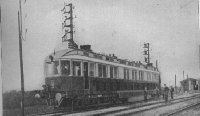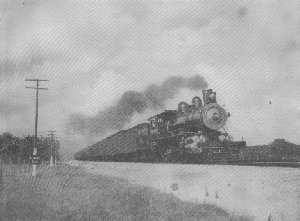|
One frequently reads about trains going at the rate of 100 miles an hour, but few people have ever ridden at a speed of more than 75 or 80 miles. On a little railroad extending from the suburbs of Berlin to the town of Zossen, an electric car travels daily as fast as 110 miles an hour, which breaks all records for speed on the highways of steel.
The car is divided into three compartments with seats extending transversely, while the motorman is separated from the passengers by a glass partition. What engineers call the three-phase system of electricity is utilized for running the car and the two trailers which it has been hauling during the experiments. Instead of the current being conveyed by one or two wires to the motor, it passes over a series of four, three of which are carried along the side of the railroad upon posts. These are known as high tension, and are capable of supporting a current of no less than 12,000 volts, owing to the system of conduction and insulation. The current passes through the trolley bar, which, as will be noticed, is a very elaborate affair, and thence through transformers to the motor.
The inventor of this car claims that within a few years will come a complete revolution of travel on rail, and that electricity with car of this type will make an average of one hundred miles an hour with as much ease as a speed of 50 miles an hour is now made. Recent experiments with this car have proved conclusively that it can go at a speed of 110 milk- an hour without apparent danger, and with absolute freedom from swaying motion. In this country, the genius of Edison has recently resulted in the construction of an improved style of trolley car whose speed closely approximates that of the Prussian invention. Experiments made on a short line in New Jersey, built especially for such a test, indicated that 100 miles an hour could be made with absolute safety and perfect comfort to passengers. Among the novelties in electric propulsion are trolley cars operated in some of the large American and European cities, without the aid of tracks, and large quantities of freight are transported in this manner.
BREAD SUPPLIED FROM THE ATMOSPHERE |


